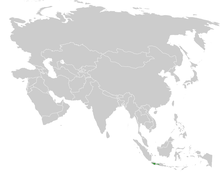The pygmy bushtit (Aegithalos exilis) is a species of bird in the bushtit family Aegithalidae.[2] The species was once placed, along with the rest of its family, with the true tits, Paridae.[3]
| Pygmy bushtit | |
|---|---|

| |
| Scientific classification | |
| Domain: | Eukaryota |
| Kingdom: | Animalia |
| Phylum: | Chordata |
| Class: | Aves |
| Order: | Passeriformes |
| Family: | Aegithalidae |
| Genus: | Aegithalos |
| Species: | A. exilis
|
| Binomial name | |
| Aegithalos exilis (Temminck, 1836)
| |

| |
| Synonyms | |
|
Psaltria exilis | |
It is endemic to Indonesia, where it occurs only on the island of Java. On Java it is restricted to montane forests and plantations above 1,000 m (3,300 ft) and occasionally down to 830 m (2,720 ft) in the west of the island. It frequents conifer forest and other open forest types, and is often encountered on the forest edge.[3]
The pygmy bushtit is the smallest member of its family, and the smallest passerine. It is 8.5 to 8.7 cm (3.3–3.4 in) in length.
The pygmy bushtit was formerly placed in its own monotypic genus Psaltria. It was moved to the current genus Aegithalos based on the results of a molecular phylogenetic study published in 2016.[4][5]
References
edit- ^ BirdLife International. (2016). "Psaltria exilis". IUCN Red List of Threatened Species. 2016: e.T22712032A94316107. doi:10.2305/IUCN.UK.2016-3.RLTS.T22712032A94316107.en. Retrieved 9 July 2020.
- ^ "Pygmy Tit (Psaltria exilis)". The Internet Bird Collection. Retrieved 1 December 2011.
- ^ a b Harrap, Simon (2008), "Family Aegithalidae (Long-tailed Tits)", in del Hoyo, Josep; Elliott, Andrew; Christie, David (eds.), Handbook of the Birds of the World. Volume 13, Penduline-tits to Shrikes, Barcelona: Lynx Edicions, pp. 76–101, ISBN 978-84-96553-45-3
- ^ Johansson, U.S.; Ericson, P.G.P.; Fjeldså, J.; Irestedt, M. (2016). "The phylogenetic position of the world's smallest passerine, the Pygmy Bushtit Psaltria exilis". Ibis. 158 (3): 519–529. doi:10.1111/ibi.12377.
- ^ Gill, Frank; Donsker, David; Rasmussen, Pamela, eds. (July 2021). "Bushtits, leaf warblers, reed warblers". IOC World Bird List Version 11.2. International Ornithologists' Union. Retrieved 7 December 2021.
